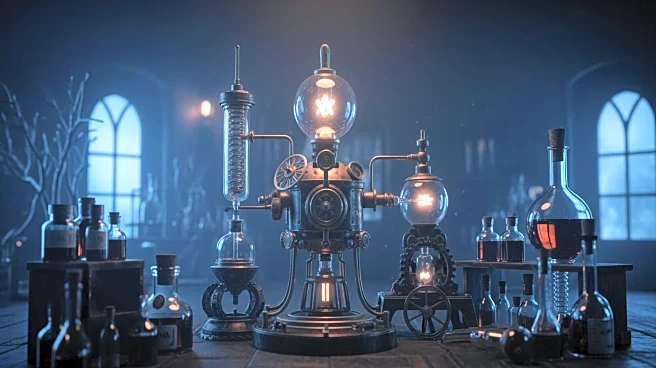What's Happening?
Netflix's new adaptation of Mary Shelley's 'Frankenstein,' directed by Guillermo del Toro, presents a unique take on the classic tale by portraying the Creature, played by Jacob Elordi, as a romantic figure.
Unlike traditional depictions of Frankenstein's monster, Elordi's character is designed to be aesthetically appealing, challenging the conventional image of the Creature as grotesque. The film explores themes of beauty, love, and human connection, with Victor Frankenstein, played by Oscar Isaac, initially embracing his creation with joy. The adaptation diverges from Shelley's original narrative by emphasizing the Creature's self-healing abilities and fluid movements, making him a more dynamic and attractive character.
Why It's Important?
This adaptation of 'Frankenstein' is significant as it reflects contemporary cultural shifts towards romanticizing traditionally monstrous figures. By presenting the Creature as a beautiful and emotionally complex character, the film taps into current trends in fantasy and romance genres, where audiences are increasingly drawn to narratives that blend horror with romantic elements. This approach may influence future adaptations of classic literature, encouraging filmmakers to explore new dimensions of well-known stories. Additionally, the film's portrayal of the Creature challenges societal perceptions of beauty and acceptance, potentially sparking discussions on the nature of humanity and the value of aesthetic appeal.
What's Next?
The release of this adaptation may lead to further exploration of romantic themes in horror and fantasy films, as audiences respond to the novel portrayal of Frankenstein's Creature. It could inspire other filmmakers to reinterpret classic tales with a focus on emotional depth and visual appeal. The film's reception will likely influence Netflix's future content strategy, potentially leading to more projects that blend genres and challenge traditional narratives. As viewers engage with the film, discussions around the ethical implications of creating life and the societal impact of beauty standards may emerge, contributing to broader cultural conversations.
Beyond the Headlines
The film's depiction of the Creature as a romantic hero raises ethical questions about the manipulation of life and the consequences of playing God. It also touches on cultural themes of acceptance and the desire for connection, highlighting the Creature's struggle for belonging in a world that initially rejects him. This adaptation may prompt audiences to reconsider the boundaries between humanity and monstrosity, exploring the idea that beauty and love can transcend physical appearance. The film's innovative approach could lead to a reevaluation of how classic literature is adapted for modern audiences, emphasizing emotional resonance over traditional horror elements.











